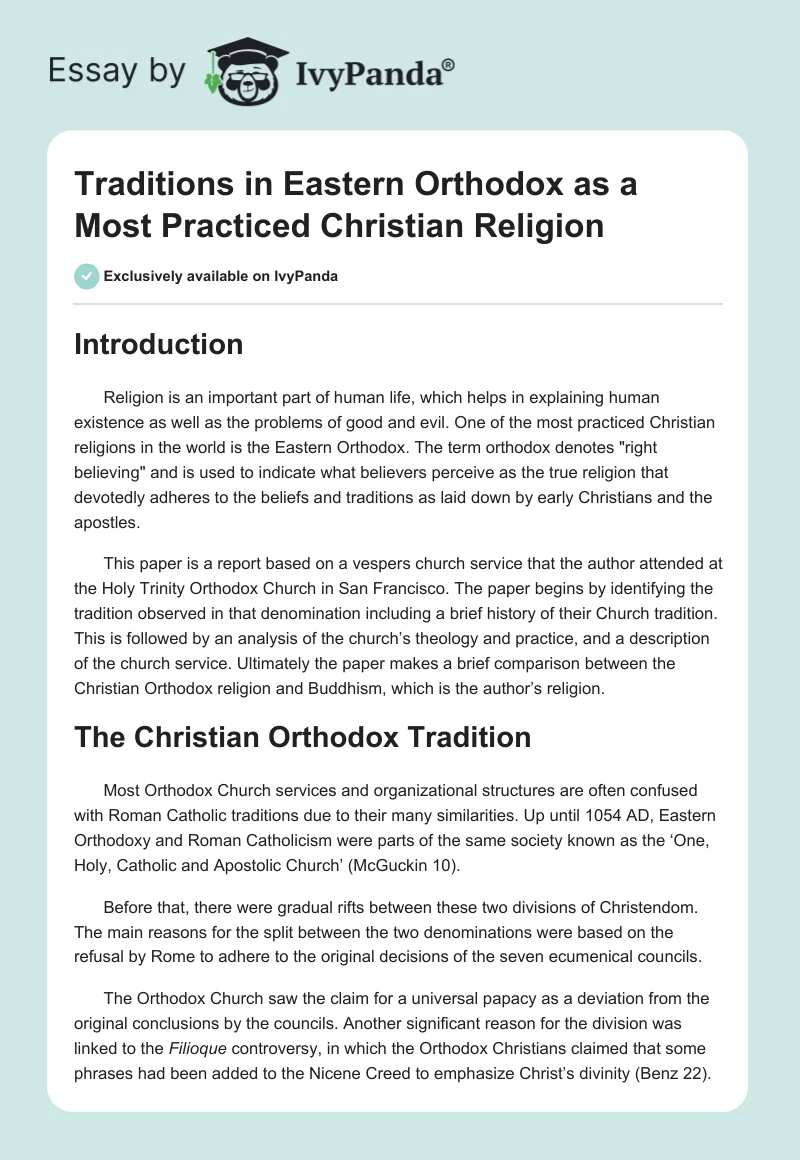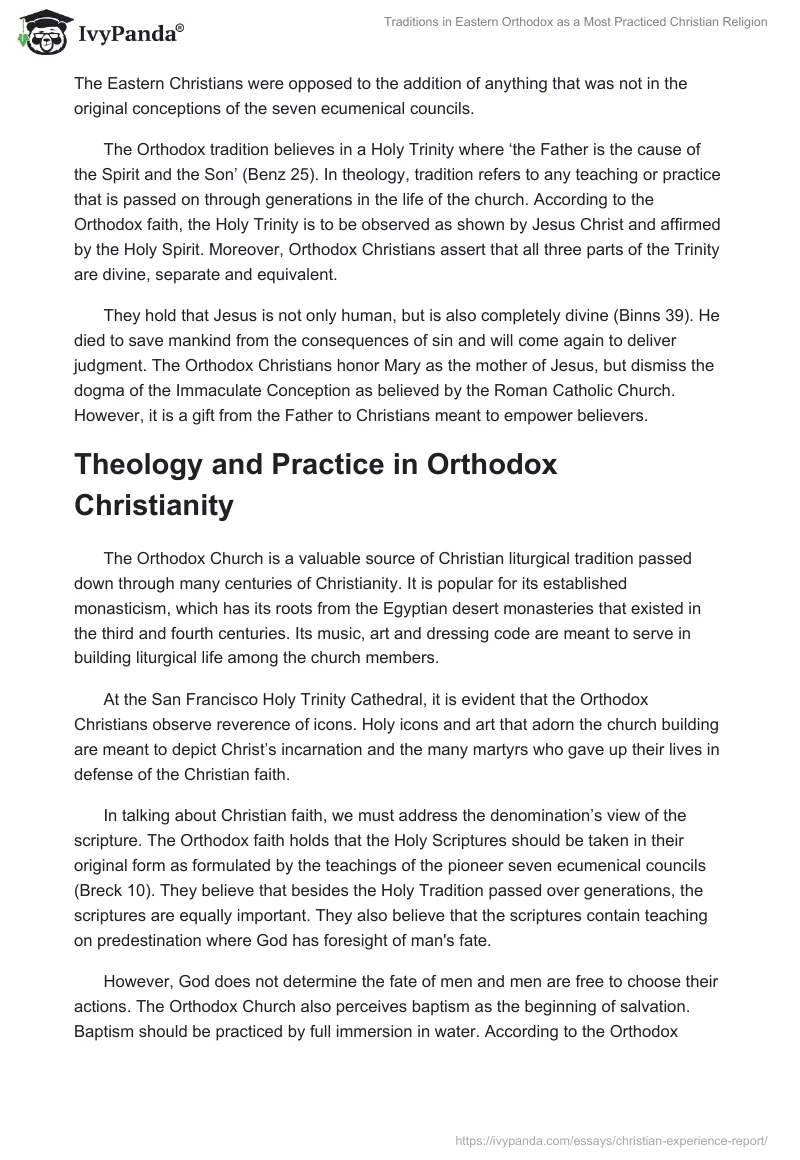Introduction
Religion is an important part of human life, which helps in explaining human existence as well as the problems of good and evil. One of the most practiced Christian religions in the world is the Eastern Orthodox. The term orthodox denotes “right believing” and is used to indicate what believers perceive as the true religion that devotedly adheres to the beliefs and traditions as laid down by early Christians and the apostles.
This paper is a report based on a vespers church service that the author attended at the Holy Trinity Orthodox Church in San Francisco. The paper begins by identifying the tradition observed in that denomination including a brief history of their Church tradition. This is followed by an analysis of the church’s theology and practice, and a description of the church service. Ultimately the paper makes a brief comparison between the Christian Orthodox religion and Buddhism, which is the author’s religion.
The Christian Orthodox Tradition
Most Orthodox Church services and organizational structures are often confused with Roman Catholic traditions due to their many similarities. Up until 1054 AD, Eastern Orthodoxy and Roman Catholicism were parts of the same society known as the ‘One, Holy, Catholic and Apostolic Church’ (McGuckin 10).
Before that, there were gradual rifts between these two divisions of Christendom. The main reasons for the split between the two denominations were based on the refusal by Rome to adhere to the original decisions of the seven ecumenical councils.
The Orthodox Church saw the claim for a universal papacy as a deviation from the original conclusions by the councils. Another significant reason for the division was linked to the Filioque controversy, in which the Orthodox Christians claimed that some phrases had been added to the Nicene Creed to emphasize Christ’s divinity (Benz 22). The Eastern Christians were opposed to the addition of anything that was not in the original conceptions of the seven ecumenical councils.
The Orthodox tradition believes in a Holy Trinity where ‘the Father is the cause of the Spirit and the Son’ (Benz 25). In theology, tradition refers to any teaching or practice that is passed on through generations in the life of the church. According to the Orthodox faith, the Holy Trinity is to be observed as shown by Jesus Christ and affirmed by the Holy Spirit. Moreover, Orthodox Christians assert that all three parts of the Trinity are divine, separate and equivalent.
They hold that Jesus is not only human, but is also completely divine (Binns 39). He died to save mankind from the consequences of sin and will come again to deliver judgment. The Orthodox Christians honor Mary as the mother of Jesus, but dismiss the dogma of the Immaculate Conception as believed by the Roman Catholic Church. However, it is a gift from the Father to Christians meant to empower believers.
Theology and Practice in Orthodox Christianity
The Orthodox Church is a valuable source of Christian liturgical tradition passed down through many centuries of Christianity. It is popular for its established monasticism, which has its roots from the Egyptian desert monasteries that existed in the third and fourth centuries. Its music, art and dressing code are meant to serve in building liturgical life among the church members.
At the San Francisco Holy Trinity Cathedral, it is evident that the Orthodox Christians observe reverence of icons. Holy icons and art that adorn the church building are meant to depict Christ’s incarnation and the many martyrs who gave up their lives in defense of the Christian faith.
In talking about Christian faith, we must address the denomination’s view of the scripture. The Orthodox faith holds that the Holy Scriptures should be taken in their original form as formulated by the teachings of the pioneer seven ecumenical councils (Breck 10). They believe that besides the Holy Tradition passed over generations, the scriptures are equally important. They also believe that the scriptures contain teaching on predestination where God has foresight of man’s fate.
However, God does not determine the fate of men and men are free to choose their actions. The Orthodox Church also perceives baptism as the beginning of salvation. Baptism should be practiced by full immersion in water. According to the Orthodox denomination, salvation is a steady and protracted process throughout a Christian’s life as he endeavors to emulate Jesus Christ.
A Brief Description of the Worship Service: Saturday Vespers
In the Orthodox Cathedral that the author attended, the liturgical service commenced in the evening as the sun was setting. The vesper service started with the congregation reciting Psalms 104: 19-20, which was also referred to as the evening psalm by the members of the church.
They perceived that Psalm as the original act of worship, where man met his creator. That recital was followed by the Great Litany, which was essentially an introductory session where all liturgical procedures of the Church were chanted. In that litany, the church prayed for almost anything and anyone. After the litany, other psalms such as Psalms 141 were recited followed by various hymns. In the Saturday vesper, most hymns were in glorification of Christ’s resurrection.
The hymn session ended with a song that praised Mary the mother of Jesus, after which the congregation sang the vesperal. At that point, Christ was praised as the Light that illumined darkness. Afterwards, a psalm was read to introduce the spiritual theme of the day. That was followed by three different readings of the day, which were all from the Old Testament.
After the readings, prayers and petitions were presented, then hymns for the day were sung, and more hymns and prayers ensued. All that ended with the congregation singing the song of St. Simeon. The congregation was then summoned to receive the Holy Communion. After the communion, the faithful proclaimed their vision of Christ, followed by litanies of ‘thrice-holy’ that included the Lord’s Prayer. The vespers ceremony concluded with the release of the congregation with a blessing.
Comparison to Buddhism
Though essentially different from the author’s religious faith of Buddhism, the Orthodox faith contains some similarities with Buddhist practices. For instance, the practice of stillness is found in both faiths. Orthodox Christianity contains certain postures and breathing techniques synonymous with yoga and Buddhist meditation.
Orthodox Christianity involves the recital of a prayer seeking Jesus’ forgiveness. On the contrary, Buddhism employs chants of mantras in its meditations. Other similarities are based on the fact that they both seek to explain human existence and death from a divine perspective.
Conclusion
The Orthodox Christian Church bases its teachings on the practices of the early Christians and the apostles. In this church, icons are revered as symbols of faith and willingness to sacrifice one’s life for the sake of religion. Their tradition and theology are centered on the tripartite nature of the Godhead and the desire to stay faithful to Christian principles in their original forms. The experience at the Holy Trinity Cathedral provides a new spiritual experience and a chance to view Christianity from the perspective of an Orthodox faithful.
Works Cited
Benz, Ernst. The Eastern Orthodox Church: Its Thought and Life, USA: Transaction Publishers, 2008. Print.
Binns, John. An Introduction to the Christian Orthodox Churches, United Kingdom: Cambridge University Press, 2002. Print.
Breck, John. Scripture in Tradition: The Bible and Its Interpretation in the Orthodox Church, USA: St Vladimir’s Seminary Press, 2001. Print.
McGuckin, John. The Orthodox Church: An Introduction to its History, Doctrine, and Spiritual Culture, United Kingdom: John Wiley & Sons, 2010. Print.


